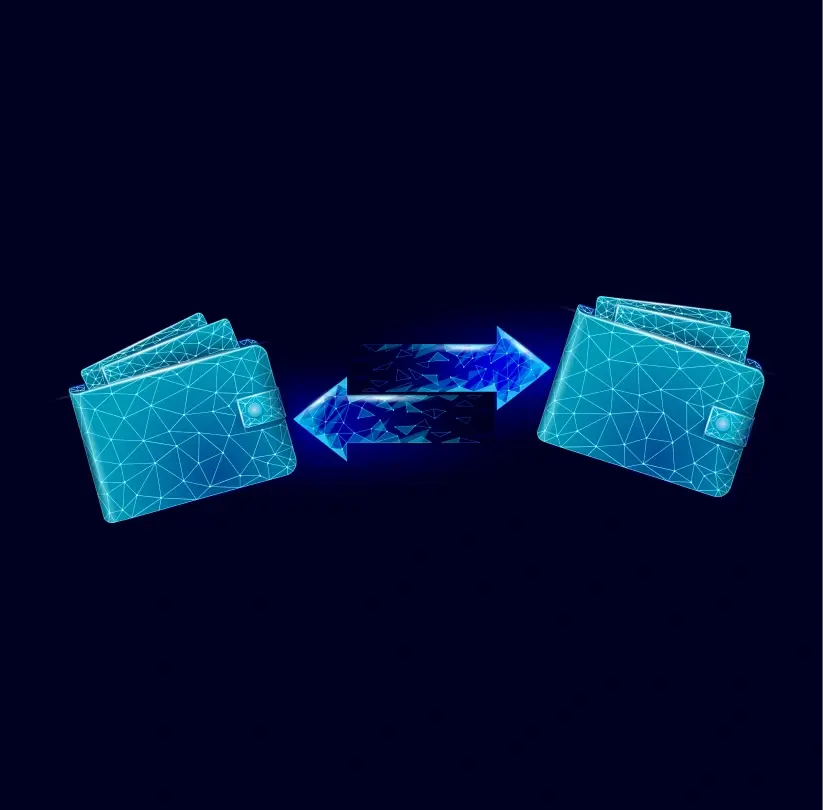Let’s explore the Web3 technology stack. Think of it like the building blocks of a new digital world. Under each blockchain project lies the reliable Web3 tech stack. Thanks to these technologies, it is possible to create top-quality decentralized applications, NFT (non-fungible token) marketplaces, crypto coins, and other solutions. The Web3 stack integrates blockchain, decentralized storage, smart contracts, and peer-to-peer networks.
Ready to discover the Web3 tech stack that enables the creation of top blockchain solutions?
Web3 stack and its features
Web 3.0 blockchain technology represents the next evolution of the Internet, emphasizing principles such as decentralization, interoperability, and user control over data. Unlike its predecessors, Web 3.0 aims to empower users, enhance privacy, and foster innovation through a more open, decentralized architecture.
What is Web3 development? So, Web 3.0, often called the decentralized web or the semantic web, is an emerging paradigm that seeks to revolutionize how information is accessed, shared, and monetized on the Internet.
At its core, Web 3.0 is characterized by decentralized technologies such as blockchain, peer-to-peer (P2P) networks, and distributed ledgers. These technologies enable a more equitable and transparent Internet ecosystem, where users have greater autonomy and ownership over their data and digital assets.
Now, let’s analyze the critical characteristics of the Web3 stack.
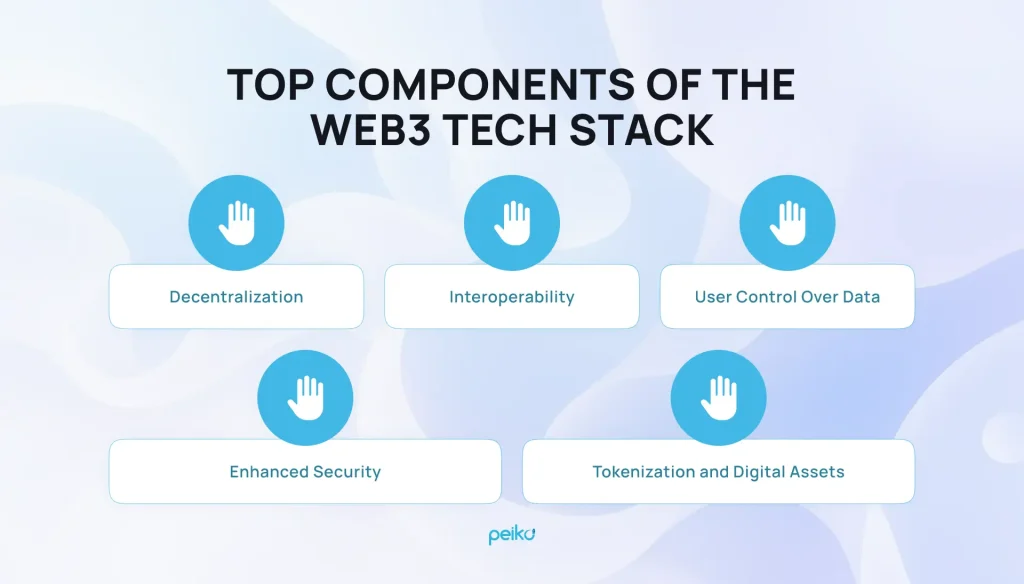
Decentralization
It is a cornerstone principle of the Web3 technology stack. Unlike Web 2.0, where power is concentrated in the hands of centralized entities such as tech giants and social media platforms, Web 3.0 distributes power and authority across a network of nodes.
Blockchain stack is crucial in achieving decentralization by eliminating the need for intermediaries and enabling trustless transactions. This decentralized architecture enhances security, reduces censorship, and promotes inclusivity.
Interoperability
This refers to the seamless exchange of data and services across different platforms and networks. In the Web3 technology stack, interoperability is facilitated by open protocols and standards that enable disparate systems to communicate and interact with each other.
This interoperability fosters innovation by allowing developers to build upon existing technologies and create new, interconnected applications and services. As a result, users can enjoy a more cohesive and integrated Internet experience.
User control over data
Web3 prioritizes user sovereignty and data privacy. It empowers users to own, control, and monetize their data. Through decentralized identity solutions and self-sovereign identity frameworks, users can manage their digital identities and selectively share information with trusted parties.
Additionally, decentralized storage platforms enable users to store data securely without relying on third-party intermediaries, reducing the risk of data breaches and unauthorized access.
Enhanced security
In general, security is a top priority in the Web3 developer stack. By using cryptographic techniques and decentralized consensus mechanisms, Web3 applications are inherently more secure and resilient to cyber-attacks. Blockchain technology, in particular, provides an auditable record of transactions, reducing the risk of fraud and manipulation.
Moreover, decentralized authentication mechanisms and multi-signature wallets enhance the security of digital assets, ensuring that users remain in control of their funds at all times.
Tokenization and digital assets
Web3 introduces the concept of tokenization, where real-world assets are represented as digital tokens on blockchain networks. These digital assets can be easily transferred, traded, and fractionalized, unlocking new opportunities for liquidity and investment.
Additionally, tokenization enables novel business models such as DeFi, NFTs, and tokenized securities, democratizing access to financial services and digital assets.
Components of Web3 technology stack
Web 3.0 blockchain technology comprises various layers, each serving a crucial role in the functioning and operation of blockchain networks. These layers ensure the integrity, security, and efficiency of decentralized systems. Let’s check the main elements of the blockchain technology stack:
Protocol layer
This layer forms the foundation of the blockchain technology stack. It contains the underlying rules, protocols, and algorithms governing how data is structured, validated, and stored within the blockchain network. Key components of the protocol layer include:
Consensus mechanisms
These algorithms enable participants in a blockchain network to agree on the validity of transactions and maintain a consistent ledger. Examples include Proof of Work (PoW), Proof of Stake (PoS), Delegated Proof of Stake (DPoS), and Practical Byzantine Fault Tolerance (PBFT).
Cryptography
It is essential for securing data on the blockchain. This involves techniques such as hashing, digital signatures, and encryption to ensure transaction and identity integrity, authenticity, and confidentiality.
Smart contracts
These smart contracts are self-executing contracts with the terms of the agreement directly written into code. They enable automated and trustless transaction execution, eliminating the need for intermediaries and enhancing efficiency in various applications.
At Peiko, we know how to create robust smart contracts for various blockchain projects. So, turn to us with any request, like Telegram crypto integrations services, NFT marketplace development, dApps development, and more.
Network layer
The network layer facilitates communication and coordination among nodes in the blockchain network. It propagates transactions, maintains network topology, and ensures connectivity and consensus among participants. Essential components of the network layer include:
Peer-to-peer (P2P) network
Blockchain networks typically operate as decentralized P2P networks, where nodes communicate directly with each other without the need for intermediaries. P2P networks facilitate data transmission, synchronization, and consensus among nodes.
Node types
Nodes in the blockchain tech stack can serve different functions. These include full nodes, which maintain a complete copy of the blockchain, and lightweight nodes or SPV (Simplified Payment Verification) nodes, which rely on full nodes for transaction verification.
Network protocols
Blockchain networks employ various network protocols to facilitate communication and data exchange among nodes. These protocols govern how nodes discover and connect, exchange messages, synchronize data, and reproduce transactions across the network.
Data layer
The data layer is responsible for storing and managing the steadfast ledger of transactions on the blockchain. It ensures data integrity, accessibility, and transparency while preserving the chronological order of transactions. Fundamental components of the data layer include:
Distributed ledger technology (DLT)
Blockchain technology stack utilizes DLT to maintain a decentralized and tamper-resistant ledger across multiple nodes. Each node stores a copy of the ledger, and transactions are recorded in blocks linked together in a chain.
Block structure
Blocks contain validated transactions and metadata such as timestamps, cryptographic hashes, and references to the previous block. The structure of blocks ensures the integrity and immutability of data on the blockchain.
Data storage mechanisms
Blockchain networks employ various data storage mechanisms, including distributed databases, cryptographic hashing, and Merkle trees, to efficiently store and retrieve transaction data while ensuring security and scalability.
Below is a diagram that shows how transaction hashes can be related to the Merkle root in a block header.
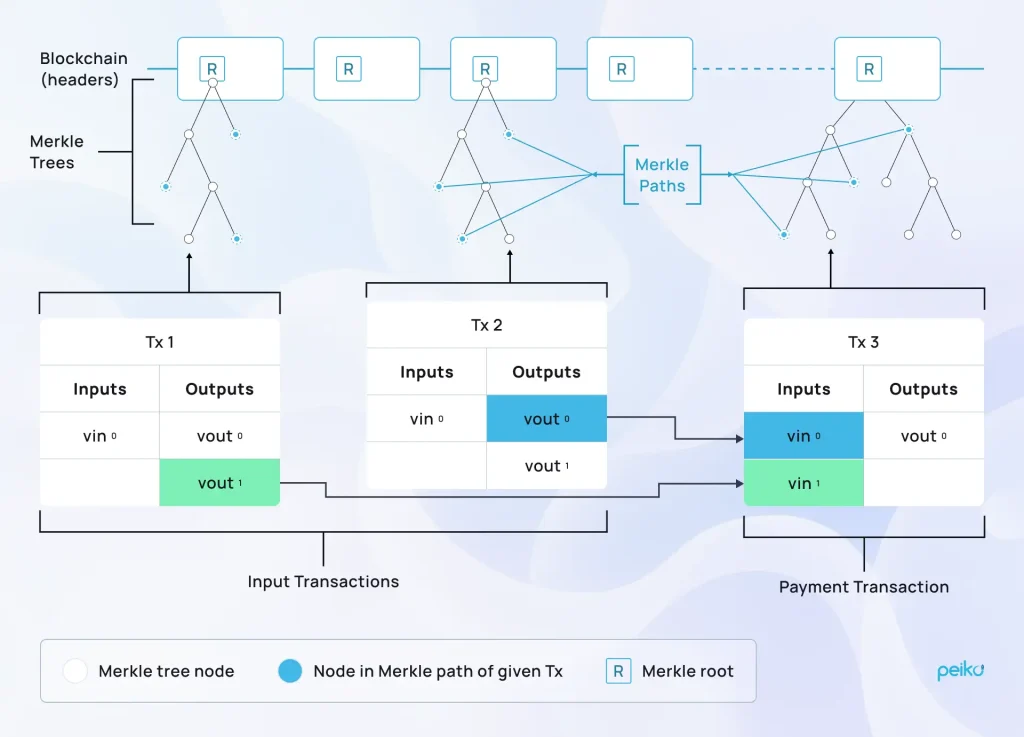
Application layer
The application layer covers the user-facing interfaces, protocols, and decentralized applications built with the blockchain development stack. It enables users to interact with the blockchain network, access services, and deploy custom applications. Critical components of the application layer include:
Decentralized applications (dApps)
They are software applications that run on decentralized blockchain networks. They use smart contracts and peer-to-peer protocols to offer services and functionalities without central control or intermediaries.
Wallets and interfaces
Wallets and user interfaces provide users with tools to manage their digital assets, interact with smart contracts, and initiate transactions on the blockchain. They come in various forms, including desktop, mobile, and web-based applications.
Interoperability protocols
These protocols enable communication and interaction between different blockchain networks and platforms. They facilitate cross-chain transactions, data exchange, and asset interoperability, enhancing the connectivity and versatility of blockchain ecosystems.
We will implement it

The development environment in the Web3 tech stack
The Web 3 stack has a range of environments, platforms, and ecosystems where developers build, deploy, and interact with DApps, smart contracts, and blockchain networks. These environments provide the infrastructure, tools, and resources necessary for Web3 development and deployment.
Our list is not a complete Web3 stack for developers, but it includes the most popular technologies.
Blockchain networks
These networks are the foundation of the Web3 ecosystem, providing decentralized, immutable, and transparent ledgers for recording transactions and executing smart contracts.
Ethereum
It is a leading blockchain platform that enables the development of smart contracts and decentralized applications. Ethereum provides a Turing-complete programming language called Solidity for writing smart contracts and tools like Truffle and Remix for development and testing.
Polkadot
It is a multi-chain blockchain platform that enables interoperability between different blockchains. Polkadot provides a Web3 framework for building custom blockchains, known as parachains, that can communicate with each other through the Polkadot relay chain. This platform aims to solve existing blockchain networks’ scalability and interoperability challenges.
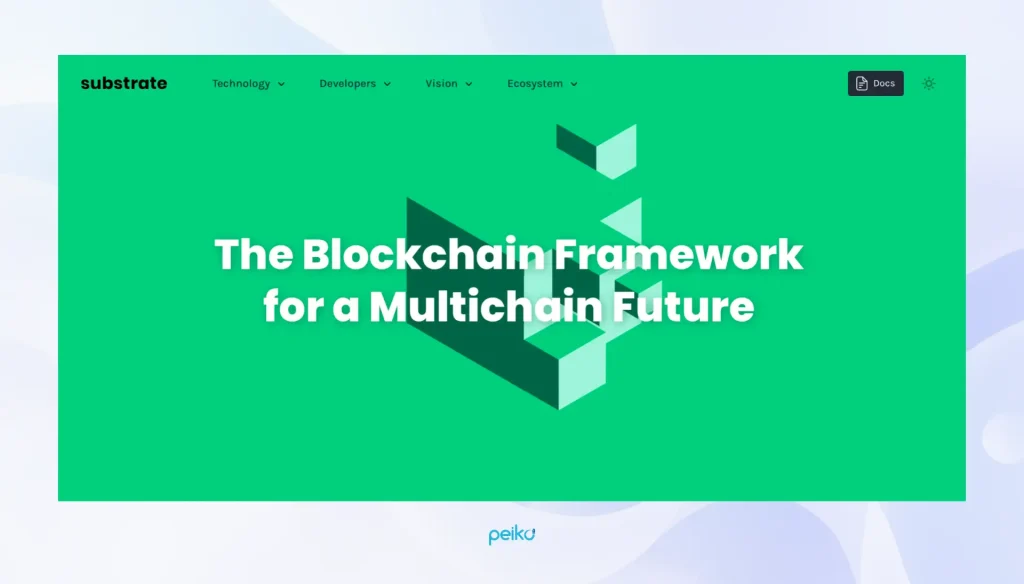
Substrate
This is a blockchain development framework developed by Parity Technologies. It provides a modular and extensible Web3 framework for building custom blockchains with specific features and functionalities. Substrate simplifies blockchain development by providing pre-built consensus, governance, and asset management modules.
Tools & protocols
These libraries, programming languages, and protocols are essential components of the blockchain tech stack for Web3 development.
Web3.js
This is a JavaScript library that allows developers to interact with Ethereum nodes and smart contracts from web applications. It provides a convenient API for performing various blockchain operations, such as reading and writing data, sending transactions, and listening for events.
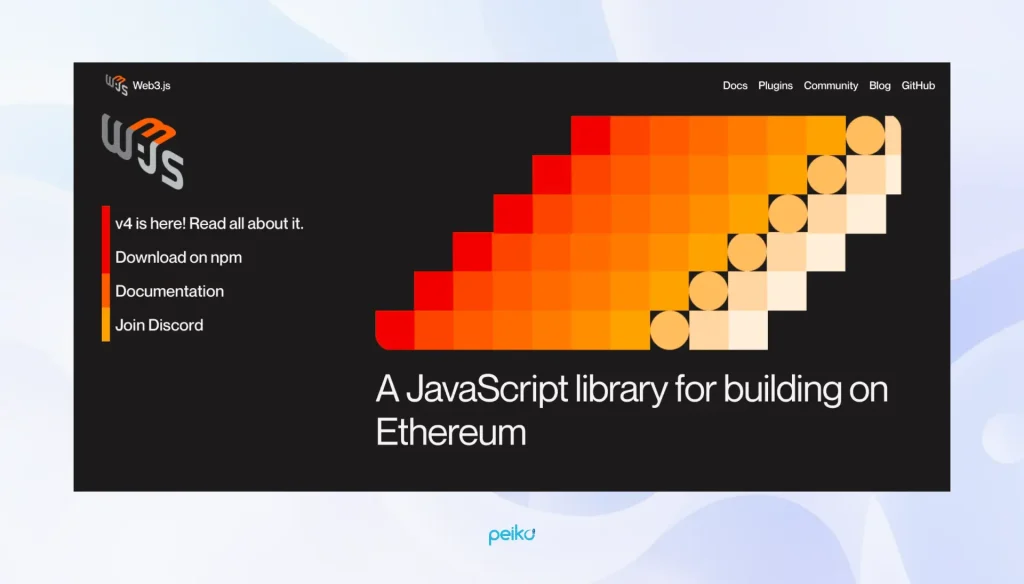
IPFS (InterPlanetary File System)
This is another vital component of the blockchain tech stack. IPFS is a decentralized storage protocol that enables the creation of distributed file systems. It allows users to store and retrieve content using content-based addressing, making it resistant to censorship and ensuring data integrity. IPFS is often used in conjunction with Ethereum to store and serve DApp content.
Chainlink
This decentralized oracle network connects smart contracts with real-world data and external APIs. It provides a secure and reliable way to access off-chain data, ensuring the accuracy and integrity of data inputs for smart contract execution. Chainlink’s decentralized oracle network prevents single points of failure and tampering.
Solidity
It is a high-level programming language for writing smart contracts on Ethereum and other EVM (Ethereum Virtual Machine) compatible blockchains. Solidity is specifically designed to write secure and auditable smart contracts that can be executed on the Ethereum blockchain. Also, Solidity supports features such as inheritance, libraries, and custom data structures.
Development environments
These environments in the blockchain tech stack provide tools and resources for building, testing, and deploying Web3 applications and smart contracts. These environments offer features such as code editors, compilers, debuggers, and testing frameworks.
Ganache
It is a local blockchain emulator and development environment for Ethereum. Ganache allows developers to create and deploy Ethereum contracts, develop DApps, and run automated tests in a local sandbox environment. This platform provides features such as built-in accounts, gas control, and blockchain exploration tools.
Remix
It is a web-based IDE (Integrated Development Environment) for Ethereum smart contract development. Remix provides syntax highlighting, code compilation, debugging, and deployment to Ethereum testnets and mainnets.
Truffle
This Web3 framework simplifies the process of building and deploying smart contracts. It provides tools for project management, testing, deployment, and support for popular Ethereum development libraries like Web3.js.
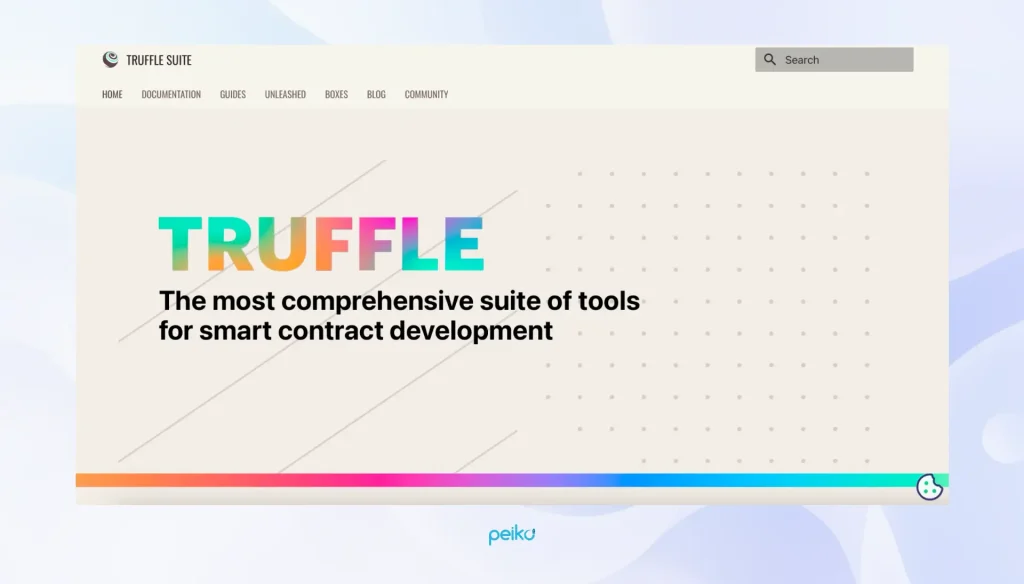
Hardhat
It is a development environment for Ethereum smart contract development that offers built-in testing, debugging, and deployment features. Hardhat is highly extensible and provides a plugin system for integrating other tools and frameworks.
Wallets and browser extensions
These extensions enable users to interact with decentralized applications, manage digital assets, and sign transactions securely. Such tools provide account management, transaction signing, and DApp integration features.
MetaMask
Within the Web3 tech stack, it is a popular Ethereum wallet and browser extension that allows users to manage Ethereum accounts, interact with DApps, and sign transactions securely. MetaMask provides key management, token support, and network switching features.
WalletConnect
This is an open protocol in the blockchain tech stack for connecting decentralized applications to mobile wallets through QR code scanning or deep linking. It enables secure communication between DApps and wallets without compromising user privacy.
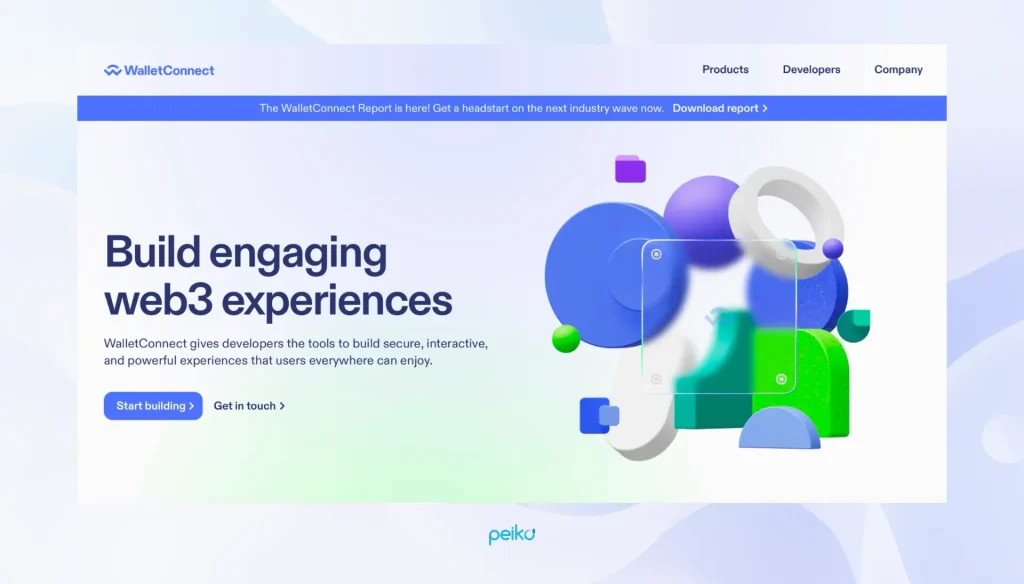
Ledger Nano S/X
Ledger Nano S and Ledger Nano X are hardware wallets that provide secure storage for digital assets and support for signing transactions offline. They offer multi-currency support, backup and recovery, and firmware updates.
Testing and deployment platforms
These platforms are essential parts of the Web3 developer stack. They enable developers to test, deploy, and monitor Web3 applications and smart contracts on various blockchain networks. Such platforms provide features such as automated testing, continuous integration, and deployment pipelines.
Infura
It is an infrastructure provider for Ethereum and IPFS that offers reliable and scalable API access to blockchain networks. It provides WebSocket support, load balancing, and analytics for monitoring network performance.
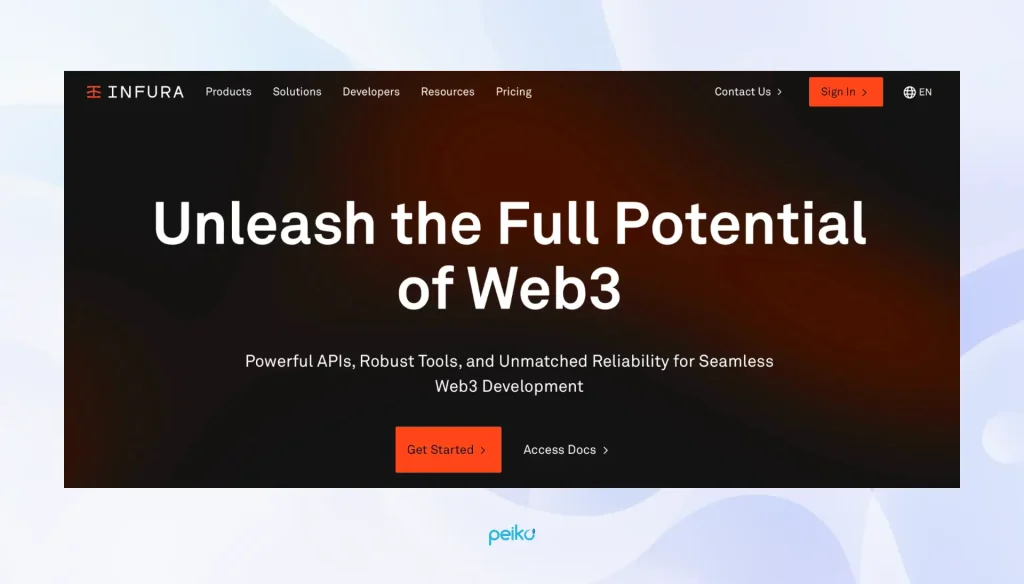
Alchemy
This blockchain infrastructure platform provides developers with tools for building, scaling, and operating Web3 applications. It offers node hosting, API access, and analytics for monitoring application performance.
Etherscan
It is a blockchain explorer and analytics platform for Ethereum that provides tools for tracking transactions, smart contracts, and network activity. This platform offers address tracking, contract verification, and token analytics features.
The Peiko team will help

Explore the comprehensive Web3 development offerings at Peiko
At Peiko, we employ the latest technologies and best practices to deliver solutions that drive your business into decentralized applications, blockchain, and the metaverse. Our complete Web3 stack for developers includes the latest technologies and tools. We are also known as an experienced marketplace development company.
DApps development
Witness the transformation of your ideas into reality with our custom-built, highly scalable dApps. Crafted with precision to align with your project’s unique requirements, our dApps stand as pillars of innovation in any niche they serve.
Cryptocurrency wallet development
Safeguard and manage your digital assets effortlessly with our reliable and secure crypto wallet solutions. Seamlessly buy, exchange, stake, and manage your Web3 assets all in one place, ensuring peace of mind and convenience.
Web3 smart contract development
Our Web3 development services include the creation of robust and secure smart contracts – the foundation of your decentralized applications. Composed by our skilled team of developers, our smart contracts form the basis of your Web 3.0 blockchain technology stack, ensuring reliability and trustworthiness.
DAO development
Empower your community to participate in your organization’s management and evolution through transparent and decentralized decision-making processes.
Web3 metaverse development
Tailored to diverse industries, including gaming, entertainment, real estate, fashion, and social media, our metaverse solutions redefine digital experiences and interactions.
Web3 game development
Using next-gen development tools like Unreal Engine 5 and Unity, our skilled developers craft stunning gaming experiences that foster innovation and creativity.
NFT marketplace development
Why choose our NFT marketplace development services? Your users will experience seamless trading and exciting live auctions within immersive 3D environments. You can also opt for our ready-to-deploy marketplace solutions for swift customization and deployment.
DeFi development
Revolutionize traditional financial services with our customized DeFi solutions. Whether it’s lending, borrowing, trading, or any other financial activity, our DeFi apps offer exceptional security, efficiency, and transparency.
Peiko blockchain development firm uses proven Web 3 stack
Need quality blockchain or web development services? Our company can boast a wide range of successfully completed projects for different sectors.
Orion Protocol is a great case study from our vast portfolio of projects. It is a decentralized platform created with the help of our proven Web 3 stack to aggregate liquidity from both CEXs (centralized exchanges) and DEXs (decentralized exchanges).
This solution provides cryptocurrency traders with advice about the best trading opportunities across different platforms at the same time. So they can make the most appropriate financial decision.

We made this platform user-friendly and feature-rich. An essential task for us was to ensure secure transactions.
Results delivered
- Top trading features. Our experts integrated advanced features from DEXs (like AMM means automated market maker) and CEXs (Order Book and TradingView). Now, users have access to greater visibility and powerful analysis tools for better decision-making.
- Cross-chain transfers. Orion Protocol asset transfers between blockchain networks are fast and seamless. This significantly expands trading opportunities for users.
- Enhanced wallet integration. We provided integration of Orion Prolotocl with popular wallets. These are MetaMask, WalletConnect, and TrustWallet. The wallets help to ensure secure and easy asset management directly on the platform.
- User-centric interface. We also added the Orion Terminal feature. This tool provides a unified interface for users to trade across multiple platforms. So the process of trading becomes more efficient.

You can find more of our successful projects, like RedLeo, luma, and Zoobdoo, in our portfolio.
Bottom line
The Web 3 stack offers exciting possibilities for developers, users, and businesses by bringing decentralization, connectivity, and user control to the Internet. With blockchain networks serving as the basis of this ecosystem, developers have access to many development environments, tools, and platforms to create innovative decentralized applications and smart contracts.
Despite the challenges, the Web3 stack continues to evolve, driving the vision of a more open, transparent, and inclusive Internet where users have greater control over their data and digital assets.
Are you ready to use Web3 developer stack power for your next project? Our full-cycle software development company is here to help you guide the complexities and unlock the potential of this transformative technology. Get in touch with us today!





